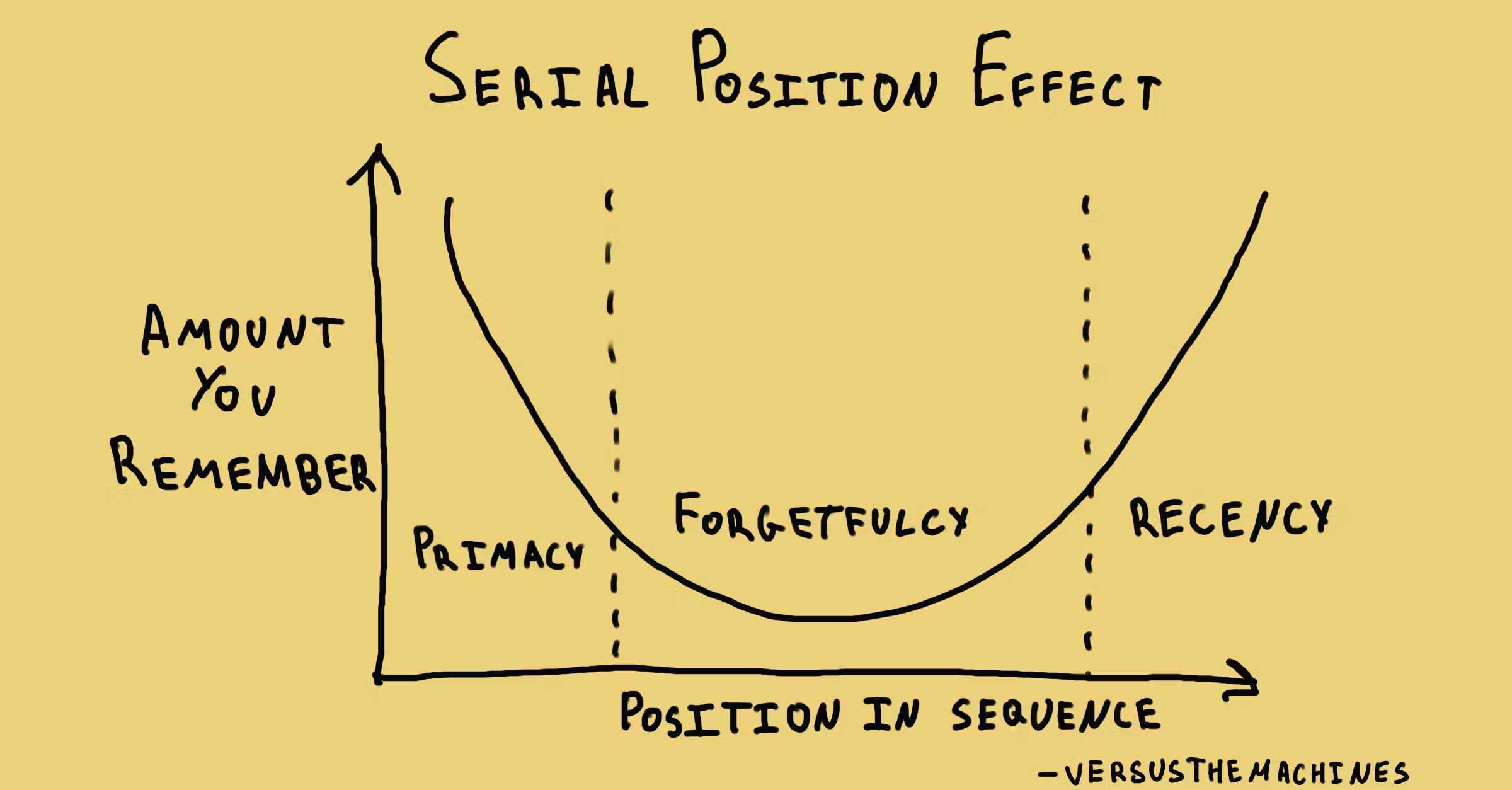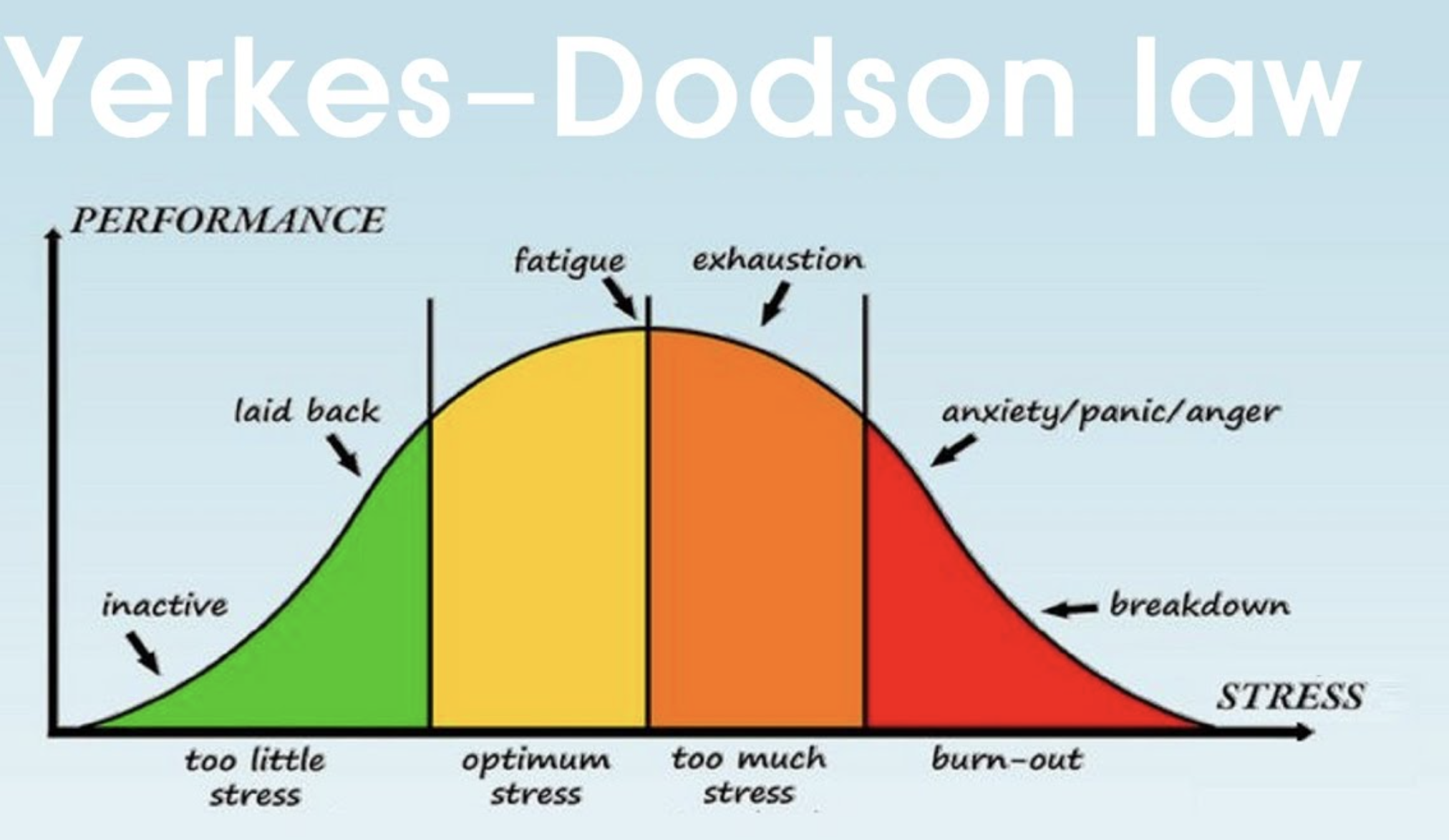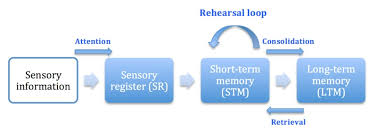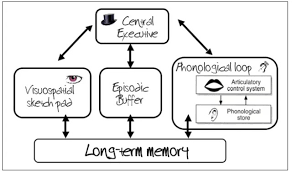Memory
1/18
There's no tags or description
Looks like no tags are added yet.
Name | Mastery | Learn | Test | Matching | Spaced |
|---|
No study sessions yet.
19 Terms
Coding research and evaluation
Coding- format in which information is stored in various memory stores
Baddeley- gave different lists of words to 4 groups of participants, and had to recall them in correct order
Immediately (STM)- best with acousticaly dissimilar: STM coded acoustically
20 mins (LTM)- best with semantically dissimilar: LTM coded semantically
G1 (acoustically similar)- cat, cab, can
G2 (acoustically dissimilar)- pit, few, cow
G3 (semantically similar)- great, large, big
G4 (semantically dissimilar)- good, huge, hot
Separate memory stores
identified clear difference between 2 memory stores
STM being acoustic and LTM being semantic has stood the test of time
helped lead to multi-store model- some exceptions though
Artificial stimuli means there is limited application
word lists do not have personal meaning
means findings do not tell us much about coding in different memory tasks in everyday life so people may use semantic coding even for STM
Capacity research and evaluation
Capacity- amount of information that can be held in a memory store
Jacobs- researcher reads out 4 digits and participants repeats them back, if correct then the research ups amount of digits read- found capacity was 9
Valid study as has been replicated- despite being old and lacking adequate controls, more controlled recent studies have found the same findings
Miller- made observations of everyday practice and found that lots of things come in sevens e.g. days, notes- though capacity was 7± 2
people can read 5 words as easily as 5 letters through chunking- grouping digits or letters into chunks
May have overestimated STM capacity- Cowan reviewed other research and concluded STM is 4 ± 1
Duration research and evaluation
Duration- length of time information can be held in memory
Peterson and Peterson (24 students have 8 tests each)
given consonant syllable e.g. YCG then told to count back from a 3 digit number (stops maintenance rehearsal)
different tests told to stop and recall between 3-18s→ 3s=80%, 18s=3%
STM duration approx. 18s unless we do maintenance rehearsal
Stimulus was artificial- does not reflect everyday activities where we try to remember something meaningful so lacks external validity
Bahrick- 392 Americans aged 17-74 using school yearbooks to test recall
remembering names from 50 photos- +15 years= 90%, +48 years=70%
free recall to just remember names +15 years= 90%, +48 years= 30%
shows LTM may last up to a lifetime
High external validity- researcher investigated meaningful memorie so findings are a real estimate on duration
Types of long term memory, tulving
Episodic memory: ability to recall information from our lives
time stamped as to when they happened and how they timely relate to other events
include several elements e.g. people and place
conscious effort to recall
Semantic memory: shared knowledge of the world e.g. word meanings
less vulnerable to distortion and forgetting
conscious effort to recall
Procedural memory: for actions and skills
may find hard to explain to someone
no conscious effort to recaoo
Explanations for forgetting- interference
Two pieces of information disrupt each other- forgetting or distortion
In LTM these memories may be available but inacessible
Proactive interference: older memory interferes with new e.g. teacher learnt many past names so cannot remember new names
Retroactive interference- newer memory interferes with older memory e.g. can no longer remember old memory of phone number as have new one
McGeoch and McDonald: studied retroactive interference by changing similarity between 2 sets of material.
Participants learnt 1 list of 10 to 100% accuracy
Then learnt new list to 100% accuracy: synonyms, antonyms, unrelated, consonant syllables, 3 numbers, control
Then had to recall original list, those who had learnt synonyms had the worst recall because the new information was interfering with the old
Shows interference is worse when memories are similar
Evaluation for long term memory types
Clinical evidence from HM and Clive Wearing
HM had episodic memory impaired due to brain damage from operation e.g. could not recall stroking dog 30mins earlier but could remember concept of a dog (semantic)
Clive Wearing had episodic memory impaired by viral infection but could stil read music, sing and play piano (procedural)
different memory stores can be damaged but others not
→ clinical studies lack control of variables as the researcher did not study memory before
Real world application- allows psychologists to help people with memory problems
age leads to people forgetting recent episodic memories
Belleville created intervention to improve episodic memory in the elderly- trained participants did better on episodic memory testing than a control group
Conflicting neuroimaging evidence (no clear support0
Buckner and Peterson: semantic memory is left prefrontal cortex and episodic memory is on the right
Tulving: argues episodic memory is left prefrontal cortex and episodic memory is on the right
Cohen and Squire: argue episodic and semantic memories are stored together in one memory store as both are consciouslly recalled- ‘declarative memory’
Tulving has argued episodic memory is sub category of semantic memory (most memories are a combination of both)
it is possible to have a functioning semantic and damaged episodic BUT NOT damaged semantic and functioning semantic
Hodges and Patterson: some people with Alzeimers can form new episoidic memory but not semantic

Evaluation for the multi-store model
Research shows that LTM and STM are different and independent
Baddeley- mix up words that sound similar in STM, and words with similar meanings in LTM
→ shown using artificial stimuli so MSM not valid model of how memory works daily
Serial position curve shows that there are separate stores
primacy: words that appear first in word list are more likely to be recalled as they are rehearsed
recency: words at end of word will still be in STM
More than one STM store
KF had amnesia due to a motorbike accident- STM poor when read aloud to but better when he read to himself (separate store for non verbal sounds)
Prolonged rehearsal not needed to transfer to LTM
MSM argues the more we rehearse something the more likely it is to go to LTM
Craik and Watkins argue that the type of rehearsal matters more- elaborative rehearsal is needed: linking rehearsal to existing knowledge or thinking about meaning
Flashbulb memories are detailed, vivid memories of event stored immediately and lasts forever e.g. 9/11, wedding day
often life changing so emotionally aroused when memory first encoded
not everything is rehearsed to go to LTM
Evaluation for the working memory model
Clinical evidence from KF- after brain injury, KF had poor STM for auditory but could process visual information. His recall of letters and digits better when he read them than when they were read to him
→ phonological loop was damaged but visual spatial sketchpad still intact (supports model)
Studies of dual task performance
Baddeley’s participants could do visual and verbal task at the same time
performance declined when both tasks were visua or both verbal
similar tasks compete for same slave subsystem but not compeition when they are different tasks
→ used tasks unlike tasks that we perform in our everyday lives and done in lab conditions
Nature of the central executive- lack of clarity over how the central executive works
Baddeley “most important but least understood part of the working memory”
needs to be more specified as being unclear challenges the integrity of the model
Evaluation for retrieval failure
Retrieval cues can help overcome forgetting in everyday life- may not have a strong effect but worth paying attention to e.g. environment where we first learnt
Research support- lack of relevant cues at recall can lead to context and state dependent forgetting, occurs in real world situations
→ Baddley argues that context effects are not very strong especially in everyday life as environments are generally not different enough so does not explain much everyday forgetting
Context effects may depend substandially on the type of memory being tested
Godden and Baddeley replicated underwater experiment but used a recogniton test insetad of recall- had to say whether they recognised words read to them from a list
Performance was then the same in all 4 conditions showing context effects only apply when a person has to recall
Encoding specificity principle- how is it possible to know when a cue is encoded, means certain studies are based on assumptions rather than actual evidence
Evaluation for cognitive interview
Kohnken- supporting evidence
did meta analysis of 55 studies comparing cogntive interview with standard police interview
cognitive interview gave 41% higher accurate information compared with standard review (only 4 in analysis showed no difference)
shows cognitive interview helps get information not immediately accessible
→ enhanced cognitive interview found more incorrect details (quantity>quality)
Reinstate the context and report everything prevents issues with leading questions and context-dependent forgetting
Not all elements of cognitive interview are useful, Mihne and Bill- some find reverse the order and change perspective confusing which weakens credibility of overall cognitive interview
Cogntitive interview is time consuimg
completing it takes more time and training than the standard police interview
more time to build rapport and allow witnesses to relax
not realistic for police forces to do
Evaluation of anxiety affecting eye witness testimony
Valentine and Mesout- research evidence
volunteers wore heart monitors in horror labyrinth in London dungeons
split to high and low anxiety
had to describe person they encountered in labyrinth- those with low anxiety had 75% recall, those with high anxiety had 17% recall
anxiety has a negative effect on recall
Christianson and Hubinette- research evidence
interviewed 58 witnesses to actual bank robbery (some bystanders and some workers)
75% overall accuracy- workers more direct so therefore more anxious had higher accuracy
anxiety has a positive effect on recall
→ interviewed them 4-15 months after, other factors such as post event discussion may be a confounding variable
Inverted-U explanation is too simplistic
anxiety now hard to define and measure accurately as has many characteristics e.g. cognitive, behavioural, emotional
ignores other aspects that impact eye witness testimony
Johnson and Scott, pen vs knife- participants may focus on weapon not person because it is unusual not because it is anxiety inducing
Pickel showed participants video of hairdressing salon where person had gun, scissors, raw chicken or wallet
eye wtiness testimony for actual person lowest when holding chicken or gun as these were the most unusual
shows weapon focus is due to unusualness so does not shows anxiety’s effect on EWT.
Evaluation for misleading information effecting eye witness testimony
Research into misleading information has practical uses in the criminal justice system
consequences of inaccurate eye witness testimony can be serious so police have to be careful
psychologists can act as expert witnesses and improve the way the legal system works in order to protect innocent people
→ practical application of eye witness testimony of eye witness testimony affected by research issues
loftus and palmer (car having bumped, collided etc.) watched their film clips in a lab which is different from the real event
eyewitnesses have more important consequences in real world as less motivation in research
eye witness testimonies may be more dependable than studies suggest
EWT is more accurate for some aspects of an event than others
Sutherland and Hayne, participants had more accurate recall for central details because core memories are resistant to misleading information
Demand characteristics- answers given by participants in lab studies are because participants want to be useful and not let researchers down (often guess)
Evidence that post event dicussion alters eyewitness testimony
Skaberg and Wright, film clips where one mugger had light brown hair and the other dark
PED led to a blend of two “medium brown”- memory distorted by contamination
Evaluation for interference
Real world interference- increase validity of theory
baddeley and hitch asked rugby players to recall the names of teams they had played against during a season.
players who had played the most had the worst recall because they had the most interference
→ interference is unusual as conditons necessary are rare as memories have to be fairly similar to interfere with each other- occasionally possible but not often
McGeoch and McDonald and other studies involve learning artifical words in a lab setting so less motivation, does not reflect how we usually use memory (lacks ecological validiity)
Interference is temporary and can be overcome using cues
Tulving and Psotka gave participants list of words organised into categories. 70% recall for first list but worsened as participants learnt each additional list. when given a cue for the category, recall rose back to 70%
→ interference caused temporary loss of accessibiity which is not predicted in interference theory.

Anxiety affecting eye witness testimony
Negative effect on recall- anxiety creates physiological arousal which prevents us from noticing important cues (presence of a weapon creates anxiety)
Johnson and Scott- participants believed they were doing a lab study and waited in waiting room
Condition 1: heard casual conversation and then man came out with pen
Condition 2: heard heated argument, broken and glass and then man came out with bloody knife
49% of C1 could identify man out of 50 photos
33% of C2
tunnel theory- vision focuses on weapon not man
Positive effect on recall- anxiety triggers fight or flight which increases alertness and memory, from an evolutionary perspective this is adaptive so that you know how act in future danger
Yuille and Curshall- studied actual shooting in gun shop where the owner shot the thief dead
13 witnesses took part 4-5 months after
measured on details they recorded and stress they felt at the time on scale of 1-7
highest stress 13% more accurate than least stressed (anxiety may enhance EWT)
Deffenbacher- reviewed 21 studies of EWT, and argued there is an optimum level of anxiety which helps us to have balance between fight or flight, an pure panic- Yerkes/Dodson law
Cognitive interview improving eye witness testimony
method of investigating/ interviewing eyewitnesses to help them retrieve more accurate memories- obtains maximum information while minimising interviewer’s influence
Fischer and Geiselman
Report everything: include every detail of event as may be important as it triggers more important memories.
Reinstate the context: witness should return to crime scene in their mind and imagine environment and emotions- stops context dependent forgtting
Reverse the order: events recalled in different order to original sequence to prevent people reporting expectations, also harder to lie
Change perspective: recall as if from other person’s perspecive (stops schema)
enhanced cognitive interview- focuses on social dynamics e.g. reducing anxiety, slowing speech, minimising distractions, open ended questions, no judgement, adapting language
explanation for forgetting- retrieval failure
encoding specificity principle- cue has to be present at encoding/ learning and at retrieval. If cues are different/ absent at retrieval than encoding there will be some forgetting (not all cues are meaningful)
Context dependent forgetting- depends on external cue
Godden and Baddeley: studied deep sea divers who learnt list of words then recalled
land/ underwater
land/ land
underwater/ land
underwater/ underwater
accurate recall was 40% lower in non matched conditions as external cues available at learning were different from at recall- retrieval failure.
State dependent forgetting- depends on internal cue
Carter and Cassaday: gave antihistamine drugs to participants leading to drowsiness
on drug/ on drug
not on drug/ on drug
not on drug/ not on drug
on drug/ not on drug
learnt list of words- memory worse when state at learning and recall were different
Misleading information affecting accuracy of eye witness testimony
Post event discussion- when witnesses discuss what they have seen with cowitnesses and other people which influences accuracy of witness’ recall
Gabbert- in pairs participants watched video of same crime but from different POVs
71% mistakenly recalled aspects of events they did not see but had picked up in dicussion
0% of control group (no discussion) made mistakes
Memory contamination- memories became altered and combined in discussion
Memory conformity- witnesses go along with each other to win social approval or because they doubt themselves (actual memory unchanged)
Leading questions- questions phrased to suggest a certain answer
Loftus and Palmer- 45 students watched film clips of car accidents and asked “how fast were the cars going when they … each other”
smashed, collided, bumped, hit, contacted
(40.5mph—31.8mph)
response bias: wording has no effect on memory just influences how they answer
substitution explanation: wording of leading question does change participant’s memory
those who heard “smashed” more likely to say there was broken glass

the multi-store model
maintenance rehearsal: repeat material to ourselves to stay in STM
prolonged rehearsal: when we rehearse information enough to pass to LTM
Retrieval: when we want to recall information from LTM it has to pass to STM
Sensory register- all stimuli from environment pass into this
coding= depends on store e.g. iconic= visual, echoic= sound
duration: less than half a second
capacity= very high (each eye has 100 million cells)
Short term memory
coding= mainly acoustic
duration: 18s unless rehearsed
capacity= 7± 2
Long term memory
coding= mainly semantic
duration= lifetime
capacity= practically unlimited

the working memory model
concerned with mental space that is active when we manipulate and temporarily store information
central executive- monitors incoming data, divides attention to different slave systems
limited processing capacity
does NOT store information
visuospatial sketchpad- stores visual and spatial information
capacity: 3-4
visual cache= visual data
inner scribe= arrangement of objects
phonological loop: auditory information preserved in order it arrives
phonological store: stores words you heard
coding: acoustic
capacity: 2s we read
articulatory process: does maintenance rehearsal so repeats words in loop to keep in working memory model
Episodic buffer- merges visual, spatial and verbal information with time sequencing into the long term memory (storage component of central executive)